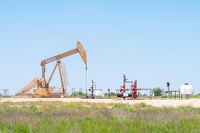Oil prices have hit their lowest levels in four years, significantly impacted by the trade offensive initiated by former President Donald Trump. As of April 7, 2025, the price of Brent crude oil from the North Sea, for delivery in June, fell by 2.09% to $64.21, after plummeting to $62.51, marking its lowest point since April 2021. This decline in oil prices, while potentially reducing pump prices for consumers, underscores a broader slowdown in the global economy.
Philippe Chalmin, a specialist in raw materials, remarked, "For the major G7 countries, perhaps with the exception of the United States, this is the only good news we have to chew on. The drop in oil prices benefits all consumer countries and, of course, weakens exporting countries." Among these exporters is the United States, where the price of West Texas Intermediate (WTI)—the American benchmark—has fallen to $59, dipping below the profitability threshold for many producers.
Chalmin further warned that Trump's trade measures could lead to a decrease of at least 1.5% to 2% in growth for the American economy. This anticipated slowdown might reduce global oil demand in 2025, contributing to a further decline in prices. The Kremlin is closely monitoring these developments, as Russia is one of the world's major oil exporters and has been a key player in discussions with Washington in recent weeks.
As the situation unfolds, the Kremlin has expressed growing concern over the economic storm triggered by the White House, particularly regarding the drop in oil prices. On April 8, 2025, Dmitri Peskov, the spokesperson for the Russian presidency, acknowledged the turbulence in the oil market, stating, "We are closely monitoring the situation, which is currently extremely turbulent and tense." This admission stands in stark contrast to the previously optimistic economic discourse emanating from Moscow.
Oil and gas sales account for about one-third of Russia's federal revenues, making the current price slump particularly alarming for the Kremlin. Peskov noted that state revenues are already below expectations for this time of year, creating a precarious financial situation for the Russian government, which relies heavily on hydrocarbon sales to fund its military operations in Ukraine.
The economic implications of low oil prices are significant. The Russian economy is facing high interest rates exceeding 20%, which threaten to stifle growth outside the defense sector. As a result, Russia risks becoming increasingly dependent on China, its primary oil buyer. Peskov’s remarks reflect a broader anxiety within the Kremlin about sustaining military funding amid these economic pressures.
On April 8, 2025, the Russian Ministry of Finance also raised alarms about the potential decline in budget revenues due to falling oil prices, stating, "There are risks that these revenues may decrease due to the weakening price environment." Elvira Nabioullina, the head of the Central Bank of Russia, echoed these concerns, warning that continued trade wars could lead to a decline in global trade and potentially reduce demand for Russian energy resources.
Russian Urals crude was trading at approximately $50 a barrel on April 8, 2025, its lowest level since 2023, reflecting a nearly 15% decline from its average price in March. This drop not only threatens Russia's budget but also complicates its military funding, as nearly one-third of the federal budget in 2025 relies on hydrocarbon sales.
Ukrainian leaders have seized upon these economic tensions, expressing hope that the financial strain on Moscow could impact its military operations. Andriï Iermak, the head of the Ukrainian presidential administration, stated on social media, "The lower the oil prices, the less money the Russians will have to finance their war." This sentiment underscores a strategic perspective among Ukrainian officials, who view economic pressures as a potential leverage point against Russian military aggression.
In addition to the geopolitical ramifications, the American hydrocarbon industry, which had been gearing up to drill more oil wells, is now facing a complicated landscape. Following the announcement of new tariffs by the Trump administration, the prospect of a global economic slowdown and reduced energy demand has led to a decrease in oil prices. The Organization of the Petroleum Exporting Countries (OPEC) has also indicated plans for increased production, further complicating the situation for American oil producers.
As the world watches these developments unfold, the interconnectedness of global economies becomes increasingly apparent. The trade policies initiated by the Trump administration are creating ripple effects that impact not only American consumers but also international markets and geopolitical stability. With oil prices in freefall, the implications for both consumer nations and oil-exporting countries like Russia are profound, raising questions about the future of energy markets and the global economy as a whole.
The situation remains fluid, with many variables at play. As countries navigate these economic challenges, the need for strategic responses and adaptive policies will be crucial in mitigating the impacts of falling oil prices and ensuring economic stability.









